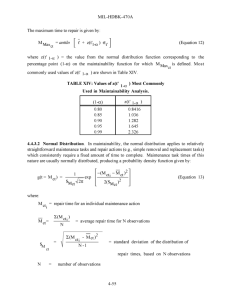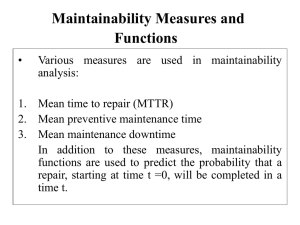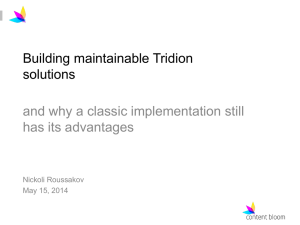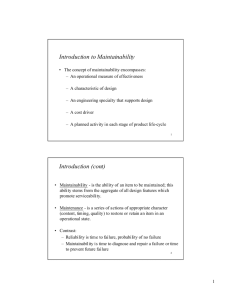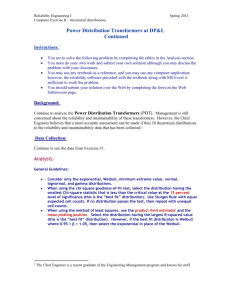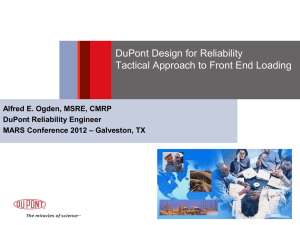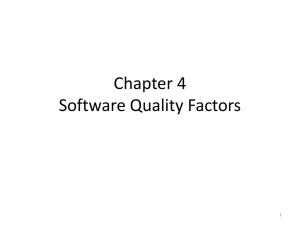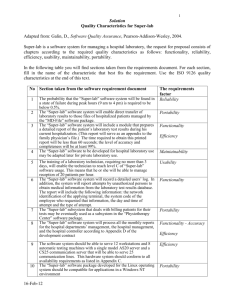Availability, Reliability, Maintainability, and Capability…
advertisement
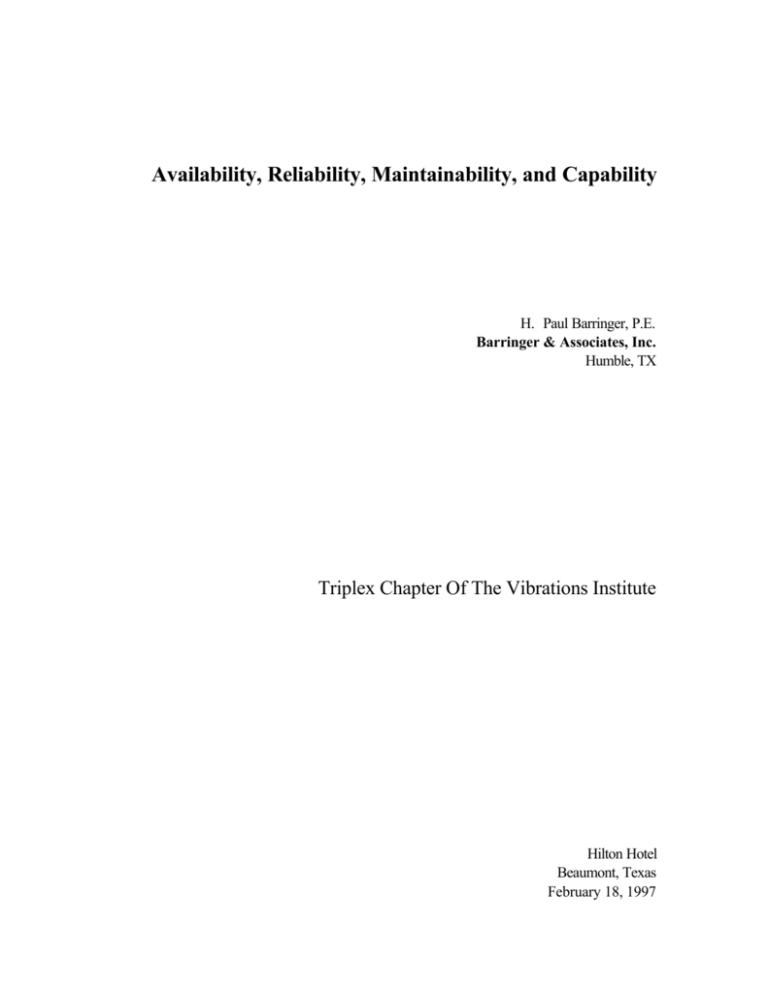
Availability, Reliability, Maintainability, and Capability H. Paul Barringer, P.E. Barringer & Associates, Inc. Humble, TX Triplex Chapter Of The Vibrations Institute Hilton Hotel Beaumont, Texas February 18, 1997 Availability, Reliability, Maintainability, and Capability H. Paul Barringer, P.E. Barringer & Associates, Inc. P.O. Box 3985, Humble, TX 77347-3985 Phone: 281-852-6810 FAX: 281-852-3749 hpaul@barringer1.com http://www.barringer1.com Availability, reliability, maintainability, and capability are components of the effectiveness equation. The effectiveness equation is a figure of merit which is helpful for deciding which component(s) detract from performance measures. In many continuous process plants the reliability component is the largest detractor from better performance. Calculation of the components are illustrated by use of a small data set. Effectiveness is defined by an equation as a figure-of-merit judging the opportunity for producing the intended results. The effectiveness equation is described in different formats (Blanchard 1995, Kececioglu 1995, Landers 1996, Pecht 1995, Raheja 1991). Each effectiveness element varies as a probability. Since components of the effectiveness equation have different forms, it varies from one writer to the next. Definitions of the effectiveness equation, and it’s components, generate many technical arguments. The major (and unarguable economic issue) is finding a system effectiveness value which gives lowest long term cost of ownership using life cycle costs, (LCC) (Barringer 1996a and 1997) for the value received: System effectiveness = Effectiveness/LCC Cost is a measure of resource usage. Lower cost is generally better than higher costs. Cost estimates never include all possible elements but hopefully includes the most important elements. Effectiveness is a measure of value received. Clements (1991) describes effectiveness as telling how well the product/process satisfies end user demands. Higher effectiveness is generally better than lower effectiveness. Effectiveness varies from 0 to 1 and rarely includes all value elements as many are too difficult to quantify. One form is described by Berger (1993): Effectiveness = availability * reliability * maintainability * capability In plain English, the effectiveness equation is the product of: --the chance the equipment or system will be available to perform its duty, --it will operate for a given time without failure, --it is repaired without excessive lost maintenance time and --it can perform its intended production activity according to the standard. Each element of the effectiveness equation requires a firm datum which changes with name plate ratings for a true value that lies between 0 and 1. Berger’s effectiveness equation (availability * reliability * maintainability * capability) is argued by some as flawed because it contains availability and components of availability (reliability and maintainability). Blanchard’s effectiveness equation (availability*dependability*performance) has -2- similar flaws. For any index to be successful, it must be understandable and creditable by the people who will use it. Most people understand availability and can quantify it. Few can quantify reliability or maintainability in terms everyone can understand. The effectiveness equation is simply a relative index for measuring “how we are doing”. Consider these elements of the effectiveness equation for refineries and chemical plants. In many continuous process industries, availability is high (~85 to 98%), reliability is low (~0.001 to 10%) when measured against turnaround intervals, and maintainability is high (~50 to 90%) when measured against the allowed time for repairs, and productivity is high (~60 to 90%). So what does the effectiveness equation tell about these conditions? The one element destroying effectiveness is the reliability component (Barringer 1996b)—so it tells where to look for making improvements. Can the effectiveness equation be used to benchmark one business to another? In theory yes, but in practice no. The practical problem lies in normalizing effectiveness data across companies and across business lines. For example, one plant may have an acceptable mission time for their equipment of one year, whereas a second plant may require a five year mission time because of their turnarounds. Similarly, one plant may set a repair time for a specific pump as 8 hours elapsed time for a two man crew and the second plant may allow 12 hours elapsed time for a two man crew. At best, the effectiveness equation is applicable within a company where similar rules are applied across operating plants and the cost structure is similar. The importance of quantifying elements of the effectiveness equation (and their associated costs) is to find areas for improvement. For example, if availability is 98%, reliability is 70%, maintainability is 70%, and capability is 65%, the opportunity for improving capability is usually much greater than for improving availability. Table 1: Raw Data From Operating Logs Wall Clock Hours Start 0 708.2 711.7 754.1 754.7 1867.5 1887.4 2336.8 2348.9 4447.2 4452 4559.6 4561.1 5443.9 5450.1 5629.4 5658.1 7108.7 7116.5 7375.2 7384.9 7952.3 7967.5 8315.3 Table 1 contains a simple data set used to illustrate how some “—abilities” are calculated. Events are put into categories of up time and down time for a system. Because the data lacks specific failure details, the up time intervals are often considered as generic age-to-failure data. Likewise, the specific maintenance details are often consider as generic repair times. Add more details to the reports to increase their usefulness. This limited data can be helpful for understanding the effectiveness equation—even though most plant level people do not acknowledge the have adequate data for analysis (Barringer 1995). -3- End 708.2 711.7 754.1 754.7 1867.5 1887.4 2336.8 2348.9 4447.2 4452 4559.6 4561.1 5443.9 5450.1 5629.4 5658.1 7108.7 7116.5 7375.2 7384.9 7952.3 7967.5 8315.3 8317.8 Total = MTBM= MTTR= Elapsed Time For Up Time 708.2 Elapsed Time For Down Time 3.5 42.4 0.6 1112.8 19.9 449.4 12.1 2098.3 4.8 107.6 1.5 882.8 6.2 179.3 28.7 1450.6 7.8 258.7 9.7 567.4 15.2 347.8 8205.3 683.8 2.5 112.5 9.4 Availability deals with the duration of up-time for operations and is a measure of how often the system is alive and well. It is often expressed as (up-time)/(up-time + downtime) with many different variants. Up-time and downtime refer to dichotomized conditions. Up-time refers to a capability to perform the task and downtime refers to not being able to perform the task, i.e., uptime ≡ not downtime. Also availability may be the product of many different terms such as: A = Ahardware * Asoftware * Ahumans * Ainterfaces * Aprocess and similar configurations. Availability issues deal with at least three main factors (Davidson 1988) for: 1) increasing time to failure, 2) decreasing downtime due to repairs or scheduled maintenance, and 3) accomplishing items 1 and 2 in a cost effective manner. As availability grows, the capacity for making money increases because the equipment is inservice a larger percent of time. Three frequently used availability terms (Ireson 1996) are explained below. Inherent availability, as seen by maintenance personnel, (excludes preventive maintenance outages, supply delays, and administrative delays) is defined as: Ai = MTBF/(MTBF + MTTR) Achieved availability, as seen by the maintenance department, (includes both corrective and preventive maintenance but does not include supply delays and administrative delays) is defined as: Aa = MTBM/(MTBM + MAMT) Where MTBM is mean time between corrective and preventive and MAMT is the mean active maintenance time. Operational availability, as seen by the user, is defined as: maintenance actions Ao = MTBM/(MTBM + MDT) Where MDT is mean down time. A few key words describing availability in quantitative words are: on-line time, stream factor time, lack of downtime, and a host of local operating terms including a minimum value for operational availability. Even though equipment many not be in actual operation, the production departments wants it available at least a specified amount of time to complete their tasks and thus the need for a minimum availability value. An example of 98% availability for a continuous process says to expect up-time of 0.98*8760 = 8584.8 hr/yr and downtime of 0.02*8760 = 175.2 hrs/yr as availability + unavailability = 1. Now, using the data set provided above in Table 1, the dichotomized availability is 98.6% based on up time = 8205.3 hours and downtime = 112.5 hours. Of course the dichotomized view of availability is simplistic and provides worst case availability numbers. Not all equipment in a train provides binary results of only up or only down—sometimes -4- it’s partially up or partially down. Clearly the issue is correctly defining failure. In the practical world, complexities exist in the definitions for when only some of the equipment is available in a train, and the net availability is less than the ideal availability—i.e., a cutback in output occurs because of equipment failure which decreases the idealized output from say 95% to a lower value such as say 87% when failures are correctly defined. A key measure is defining the cutback (and thus loss of availability from a dichotomized viewpoint) when the cutback declines to a level causing financial losses—this is the economic standard for failure. In short, the area under the availability curve can be summed to calculate a practical level of availability and generate higher values for availability than when only dichotomized values are used. Lack of availability is a problem related to primarily to failures of equipment. But the root cause of the failure may lie in different areas than initially expected. Often deterioration, leading to economic failure, causes conflicts in the definitions of reliability, maintainability, and capability—real life issues are rarely simple and independent. For production purposes, a system must be fully available (ready for service) and reliability (absence of failures) to produce effective results. Reliability deals with reducing the frequency of failures over a time interval and is a measure of the probability for failure-free operation during a given interval, i.e., it is a measure of success for a failure free operation. It is often expressed as R(t) = exp(-t/MTBF) = exp(-λt) where λ is constant failure rate and MTBF is mean time between failure. MTBF measures the time between system failures and is easier to understand than a probability number. For exponentially distributed failure modes, MTBF is a basic figure-of-merit for reliability (failure rate, λ, is the reciprocal of MTBF). For a given mission time, to achieve high reliability, a long MTBF is required. Also reliability may be the product of many different reliability terms such as R = Rutilities * Rfeed-plant * Rprocessing * Rpackaging * Rshipping and similar configurations. To the user of a product, reliability is measured by a long, failure free, operation. Long periods of failure free interruptions results in increased productive capability while requiring fewer spare parts and less manpower for maintenance activities which results in lower costs. To the supplier of a product, reliability is measured by completing a failure free warranty period under specified operating conditions with few failures during the design life of the product. Improving reliability occurs at an increased capital cost but brings with it the expectation for improving availability, decreasing downtime and smaller maintenance costs, improved secondary failure costs, and results in better chances for making money because the equipment is free from failures for longer periods of time. While general calculations of reliability pertain to constant failure rates, detailed calculations of reliability are based on consideration of the failure mode which may be infant mortality (decreasing failure rates with time), chance failure (constant failure rates with time), or wear-out (increasing failure rates with time). -5- A few key words describing reliability in quantitative words are: mean time to failure, mean time between failures, mean time between/before maintenance actions, mean time between/before repairs, mean life of units in counting units such as hours or cycles, failure rates, and the maximum number of failures in a specified time interval. An example of a mission time of one year with equipment which has a 30 year mean time to failure gives a reliability of 96.72% which is the probability of successfully competing the one year time interval without failure. The probability for failure is 3.278% as reliability + unreliability = 1. For reliability issues, defining the mission time is very important to get valid answers. Notice from the example that high reliability for mission times of one year or more require high inherent reliability (i.e., large mean times to failure)—often the inherent reliability is not achieved due to operating errors and maintenance errors. The data in Table 1 shows the mean time between maintenance actions is 683.8 hours. Calculate the system reliability using the exponential distributions described above and a mission time of one year. The system has a reliability of exp(-8760/683.8) = 0.00027%. The reliability value is the probability of completing the one year mission without failure. In short, the system is highly unreliable (for a one year mission time) and maintenance actions are in high demand as the system is expected to have 8760/683.8=12.8 maintenance actions per year! The above calculations for reliability were driven by arithmetic calculations. More accurate projections are found by building a probability chart from the data in Table 1 using WinSMITH Weibull software (Fulton 1996). Figure 1 shows the mean time between maintenance events is 730 hours. Ninety-eight percent of all the up time will lie between 7.3 hours and 3362.3 hours. Elapsed Time Between Maintenance Events 99 O c c u r r e n c e W/rr 95 1 90 80 70 60 50 40 30 20 10 C D F 5 % 2 Eta Beta r^2 n/s 729.9988 1 1 12/0 1 1 10 100 Time (hours) -6- Figure 1: Probability Plot Of Up Time 1000 10000 Ten percent of all up times will be less than 76.9 hours. The median up time is 506 hours. So how can high availability be achieved with systems requiring many maintenance actions? The maintenance actions must be performed very quickly to minimize outages!!!!! This leads to pressures for establishing world class maintenance operations. A better way to solve the problem is to reduce the number of failures—thus demands for world class maintenance operations is avoided and costs are decreased—particularly when life cycle costs drive the actions. Remember failures carry hidden costs resulting from the hidden factories associated with production losses for disposal of scrap and the slow output incurred while reestablishing steady state conditions—the lost time may be 1.5 to 5 times the obvious lost time costs. The real issue for studying reliability is driven by a simple concept called money—particularly when the cost of unreliability (Barringer 1996c) is identified and used for motivating trade-off studies. High reliability (few failures) and high maintainability (predictable maintenance times) tend toward highly effective systems. Maintainability deals with duration of maintenance outages or how long it takes to achieve (ease and speed) the maintenance actions compared to a datum. The datum includes maintenance (all actions necessary for retaining an item in, or restoring an item to, a specified, good condition) is performed by personnel having specified skill levels, using prescribed procedures and resources, at each prescribed level of maintenance. Maintainability characteristics are usually determined by equipment design which set maintenance procedures and determine the length of repair times. The key figure of merit for maintainability is often the mean time to repair (MTTR) and a limit for the maximum repair time. Qualitatively it refers to the ease with which hardware or software is restored to a functioning state. Quantitatively it has probabilities and is measured based on the total down time for maintenance including all time for: diagnosis, trouble shooting, tear-down, removal/replacement, active repair time, verification testing that the repair is adequate, delays for logistic movements, and administrative maintenance delays. It is often expressed as M(t) = 1- exp(-t/MTTR) = 1 - exp(-µt) where µ is constant maintenance rate and MTTR is mean time to repair. MTTR is an arithmetic average of how fast the system is repaired and is easier to visualize than the probability value. Note the simple, easy to use criteria shown above , is frequently expressed in exponential repair times. A better and more accurate formula requires use of a different equation for the very cumbersome log-normal distributions of repair times describing maintenance times which are skewed to the right. The maintainability issue is to achieve short repair times for keeping availability high so that downtime of productive equipment is minimized for cost control when availability is critical. An example of a stated maintainability goal is a 90% probability that maintenance repair times will be completed in 8 hours or less with a maximum repair time of 24 hours. This requires a system MTTR of 3.48 hours. Also the cap of 24 hours (99.9% of repairs will be accomplished in this -7- time, or less) requires control of three main items of downtime: 1) active repair time (a function of design, training, and skill of maintenance personnel), 2) logistic time (time lost for supplying the replacement parts), and 3) administrative time (a function of the operational structure of the organization). The probability for not meeting the specified 8 hour repair interval in this example is 10% based on a MTTR of 3.48 hours as maintainability + unmaintainability = 1. Data in Table 1 shows mean down time due to maintenance actions is 9.4 hours. Calculate the system maintainability using the exponential distributions and an allowed repair time of 10 hours. The system has a maintainability of 1-exp(-10/9.4) = 65.5%. The maintainability value is the probability of completing the repairs in the allowed interval of 10 hours. In short, the system has a modest maintainability value (for the allowed repair interval of 10 hours)! The above calculations for maintainability were driven by arithmetic calculations. More accurate projections are found by building a probability chart from the data in Table 1. Figure 2 shows the mean down time for repairs is 10.0 hours. Ninety-eight percent of all the down time for maintenance will lie between 0.1 hours and 45.6 hours. Ten percent of all down times will be less than 1.1 hours. The median down time is 7.0 hours. Elapsed Time For Maintenance Actions 99 O c c u r r e n c e W/rr 95 1 90 80 70 60 50 40 30 20 10 C D F 5 % 2 Eta Beta r^2 n/s 10.01688 1.008 0.999 12/0 1 .1 1 10 100 Time (hours) Figure 2: Probability Plot of Maintenance Down Time A special note of caution about the exponential distribution in Figure 2. Most repair times are not exponentially distributed—they are usually log-normally distributed. However, do not worry about the distribution too much as WinSMITH Weibull software allows many different distributions to be -8- studied with ease using the New Weibull Handbook (Abernethy 1996). For engineers, the software is very helpful because their time can be used to fix things rather than worrying about arcane statistical matters. From the data in Figure 1, MTBM = 730.0 hours, and the data in Figure 2, MDT = 10.0, the operational availability can be calculated. Ao = 730/(730+10) = 98.6% which is the same value found from the calculation for (up time)/(up time + down time). High availability (high up-time), high reliability (few failures) and high maintainability (predictable and short maintenance times) tend toward highly effective systems if capability is also maintained a high levels. Capability deals with productive output compared to inherent productive output which is a measure of how well the production activity is performed compared to the datum. This index measure the systems capability to perform the intended function on a system basis. Often the term is the synonymous with productivity which is the product of efficiency multiplied by utilization. Efficiency measures the productive work output versus the work input. Utilization is the ratio of time spent on productive efforts to the total time consumed. For example, suppose efficiency is 80% because of wasted labor/scrap generated, and utilization is 82.19% because the operation is operated 300 days per year out of 365 days. The capability is 0.8*0.8219 = 65.75%. These numbers are frequently generated by accounting departments for production departments as a key index of how they are doing. Thus these calculations need few explanations. System effectiveness equations (Effectiveness/LCC) are helpful for understanding benchmarks, past, present, and future status as shown in Figure 3 for understanding trade-off information. New Plant B C Parameter Last Plant New Plant Best Plant Availability 0.95 0.95 0.98 Reliability 0.3 0.4 0.6 Maintainability 0.7 0.7 0.7 Capability 0.7 0.8 0.6 Effectiveness 0.14 0.22 0.25 80 100 95 B Worst * ? * C Trade-off Area LCC Last Plant A Best Plant Last Plant ? * Best A LCC Effectiveness Figure 3: Benchmark Data Shown In Trade-Off Format -9- The lower right hand corner of Figure 3 brings much joy and happiness often described as “bang for the buck” (Weisz 1996). The upper left hand corner brings much grief. The remaining two corners raise questions about worth and value. In summary, the elements of the effectiveness equation provide enlightenment about how things work in a continuous processing plant. Clues are provided in the effectiveness equation for where corrective action may be particularly helpful. It is important to understand both reliability and maintainability along with traditional information about availability and capability. In all cases, alternatives should be considered, based on life cycle costs, for ranking the high cost of problems so the important issues can be identified for corrective action. References— Abernethy, Dr. Robert B. (1996), The New Weibull Handbook, 2nd edition, published by the author, phone: 561-842-4082. Barringer, H. Paul and David P. Weber (1995), Where Is My Data For Making Reliability Improvements?, Fourth International Conference on Process Plant Reliability sponsored by Hydrocarbons Processing and Gulf Publishing Company, Houston, TX. Barringer, H. Paul and David P. Weber (1996a), Life Cycle Cost Tutorial, Fifth International Conference on Process Plant Reliability sponsored by Hydrocarbons Processing and Gulf Publishing Company, Houston, TX. Barringer, H. Paul (1996b), Practical Reliability Tools For Refineries and Chemical Plants, National Petroleum Refiners Association Plant Maintenance Conference and Exhibition, Nashville, TN. Barringer, H. Paul (1996c), An Overview Of Reliability Engineering Principles, Energy Week 1996, Sponsored by ASME & API and Organized by PennWell Conferences, Houston, TX. Barringer, H. Paul (1997), Life Cycle Costs & Reliability For Process Equipment, Energy Week 1997, Sponsored by ASME & API and Organized by PennWell Conferences, Houston, TX. Berger, Gene and Herzl Marouni (1993), ASQC Section 1405 Certified Reliability Refresher Course, Published by Gene Berger, Houston, TX. Blanchard, B. S., Dinesh Verma, Elmer L. Peterson 1995, Maintainability: A Key to Effective Serviceability and Maintenance Management, Prentice-Hall, Englewood Cliffs, NJ. Clements, Richard Barrett (1991), Handbook of Statistical Methods in Manufacturing, Preentice Hall, Englewood Cliffs, New Jersey. Davidson, John 1988, The Reliability of Mechanical Systems , Mechanical Engineering Publications Limited for The Institution of Mechanical Engineers, London. -10- Fulton, Wes (1996), WinSMITH Weibull probability software, version 1.1P, Fulton Findings, 1251 W. Sepulveda Blvd., #800, Torrance, CA 90502, phone 310-548-6358. Ireson, W. Grant, Clyde F. Coombs, Jr., Richard Y. Moss 1996, Handbook of Reliability Engineering and Management, 2nd edition, McGraw-Hill. Kececioglu, Dimitri 1995, Maintainability, Availability, & Operational Readiness Engineering, Prentice Hall PTR, Upper Saddle River, NJ. Landers, Richard R. 1996, Product Assurance Dictionary, Marlton Publishers, 169 Vista Drive, Marlton, NJ 08053. Pecht, Michael 1995, Product Reliability, Maintainability, and Supportability Handbook, CRC Press, New York. Raheja, Dev G. 191, Assurance Technologies, McGraw-Hill, Inc., NY. Weisz, John 1996, “An Integrated Approach to Optimizing System Cost Effectiveness”, 1996 Tutorial Notes Annual Reliability and Maintainability Symposium, available from Evans Associates, 804 Vickers Avenue, Durham, NC 27701. Biographic information— H. Paul Barringer Manufacturing, engineering, and reliability consultant and author of the basic reliability training course Reliability Engineering Principles. More than thirty-five years of engineering and manufacturing experience in design, production, quality, maintenance, and reliability of technical products. Contributor to The New Weibull Handbook, a reliability engineering text published by Dr. Robert B. Abernethy. Named as inventor in six U.S.A. Patents. Registered Professional Engineer in Texas. Education includes a MS and BS in Mechanical Engineering from North Carolina State University, and participated in Harvard University's three week Manufacturing Strategy conference. Visit the world wide web site at http://www.barringer1.com for other background details or send e-mail to hpaul@barringer1.com concerning LCC or reliability issues. HPB 1/2/97 -11-
